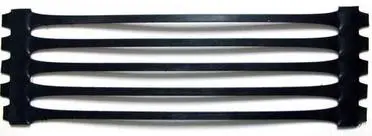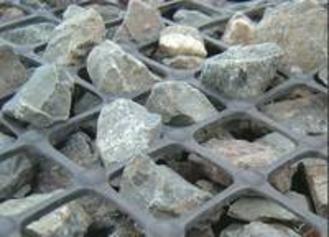High Performance Geogrid
Biaxial Geogrid is a co-polymer reinforcement panel composed of high molecular weight multi-filament polyester yarns with a PVC coating. Biaxial Geogrid is produced by punching a regular pattern of holes in sheets of the co-polymer then stretched into a grid pattern. Common usage is in soil reinforcement applications such as MSE retaining walls, roads, storage yards and load bearing structures. Biaxial Geogrid provides excellent tensile strength in both principle directions. The reinforcing action of the product lies mainly in increasing the shearing resistance within a soil by a process of interlocking between the square ribs and the soil. The load dispersal effect from the interlocking mechanism is more effective and can reduce sub-base thickness and construction cost. Biaxial Geogrid can be used with any type of fill material. One layer or multi-player construction distributes loading and disperses stress more effectively, leading to the reduction in differential and improved foundation bearing capacity.
What Is Soil Reinforcement?
Construction projects on loose soil particles often prove challenging. Loose soil particles make it difficult to build a solid foundation for the building. This being the case, most contractors opt to employ soil reinforcement techniques such as using geogrids to improve the stability of the soil.
In simple terms, soil reinforcement refers to the use of geoengineering methods to improve the compactness and strength of the soil. Today, the most common method used is the application of geogrids because of their high resistance and durable nature.
How Geogrids Work
Geogrids refer to geosynthetic materials made up of interconnected parallel sets of tensile ribs with apertures to allow strike-through for the surrounding aggregates (soil, stone, or geotechnical material). These materials work by building a firm working surface over soft, loose soil. They are designed to interlock the granular or soil materials placed over them into place. Using their open apertures, the geogrids confine the materials within to increase the strength and compactness of the overlying aggregates.
In essence, geogrids help to redistribute the load over a wider area. This mechanism has proven invaluable to constructing pavement, retaining walls, and reinforcing foundation construction.
How to Lay Geogrids
Geogrids should be installed while observing all local building codes and standards. Geogrids have specific installation methods depending if they are to be used to reinforce a solid mass behind a retaining wall or on a slope or if they are to be used to improve the design of a parking lot or highway. End-use specific installation guides are available but there are a few general rules of thumb that apply to all installation cases. Make sure the geogrid is laid flat and does not have any creases. Ensure that there are no spaces between panels of geogrid so that there is no gap in reinforcement by making sure to overlap and geogrid seams as instructed by the design engineer.
Types of Geogrids
There are three types of geogrids. Each of these grids is specially designed for specific construction needs with different tensile strengths. They include:
- Uniaxial geogrids - These grids are designed to withstand stress in a single direction. They are made by having the majority of their strength in the longitude direction with their tensile strength originating from the machine direction. They can be knitted, woven, or extruded. They are primarily used for retaining walls, embankments, and landfill liner systems over soft soils and steep slopes.
- Biaxial geogrid - These grids are designed with equal or similar tensile strength both in machine and cross direction. This means they can distribute loads over wider areas and are better suited for base stabilization applications. These grids are used in constructing foundations for railroad truck beds, roadbeds, pavements, parking lots, weak subgrades, and airport runways.
- Triaxial geogrids - These grids are very similar to biaxial geogrids and are used in the same applications.
Application of Geogrids in Construction
Applied in construction of retaining walls
In retaining wall construction, geogrids are used to reinforce the soil mass behind a wall or slope. This gives several benefits during construction including a reduction in material being brought in from off site with the construction of traditional gravity retaining walls.
Characteristics of a geogrid reinforced retaining wall system
- They have higher adaptability to foundation deformation.
- They are flexible enough to hold in an earthquake.
- The construction is more economical.
Application in Base Reinforcement
Geogrids are often used to stabilize the soil below highway, road, and parking lot surfaces.
Application in pavement construction
Geogrids are used in pavement construction to solve the problem of a soft subgrade. They are also a great way to reduce base thickness and time taken during construction. By improving the strength of the subgrade, geogrids can effectively increase the lifespan of the pavements.
Advantages of Geogrids in Construction
- Provide ease of construction
- Ensure land optimization
- Increases soil stabilization
- Increases load-bearing capacity
- Reduced maintenance costs
- Improve soil retention to reduce soil erosion
FEATURES:
High tensile strength with minimal elongation
Long-term design strength
Excellent creep resistance
Flexible and durable
Increased pull-out resistance and compound strength
Chemical and biological resistance
UV resistance
Resistance to installation damage and ease of installation
Cost effective
APPLICATIONS FEATURES:
Soil reinforcement
Roadbed and railway reinforcement and crack prevention
Increased roadbed strength
Reinforcement and stabilization of riverbank and slope
Dyke reinforcement
Increased stability and foundation loading capacity










